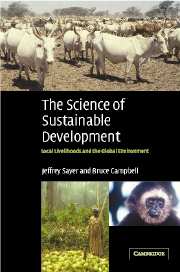Book contents
- Frontmatter
- Contents
- List of figures
- List of boxes
- List of tables
- Foreword
- Preface
- Acknowledgements
- Part I Integrating natural resource management
- Part II Realities on the ground
- 6 Institutions for managing natural resources in African savannas
- 7 Forest margins in Indonesian Borneo
- 8 Learning by doing on tropical American hillsides
- Part III The research–management continuum
- Bibliography
- Index
6 - Institutions for managing natural resources in African savannas
Published online by Cambridge University Press: 18 May 2010
- Frontmatter
- Contents
- List of figures
- List of boxes
- List of tables
- Foreword
- Preface
- Acknowledgements
- Part I Integrating natural resource management
- Part II Realities on the ground
- 6 Institutions for managing natural resources in African savannas
- 7 Forest margins in Indonesian Borneo
- 8 Learning by doing on tropical American hillsides
- Part III The research–management continuum
- Bibliography
- Index
Summary
Zimbabwe has had a long and distinguished history of agricultural science, built on the classical transfer of technology model. A number of national and international research organisations have conducted excellent on-station technological research in the country. With hindsight, it is easy to find fault with much of this work, which has failed to address the realities of small-scale farmers. In this chapter, we first explore the component science and then describe a more integrated approach, drawing on a case study in southern Zimbabwe.
Component science in complex savanna environments
A good example is the Makoholi Research Station. It is part of the Division of Livestock and Pastures, one of the divisions in the national agricultural research service. This station is 150km from Chivi, the area we return to later in this chapter. The work at Makoholi should serve the needs of smallholder farmers, the main stakeholders for work of the national research organisation. In 1993, the station housed six professional officers and six research technicians and 13 projects were being undertaken. The work covered a large number of narrowly focussed projects. These included studies of cow performance in relation to use of cows for draught power; characterisation of goat production systems; performance of goats in relation to variety, feed supplementation, dipping and watering; sheep breed digestion studies; production characteristics of forage grasses and legumes; and digestibility studies of legume trees and shrubs. Some of the work was probably quite useful.
- Type
- Chapter
- Information
- The Science of Sustainable DevelopmentLocal Livelihoods and the Global Environment, pp. 119 - 143Publisher: Cambridge University PressPrint publication year: 2003



